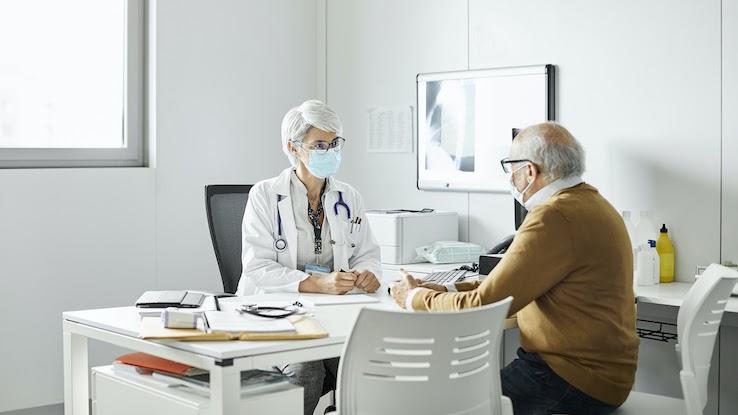Overactive Bladder Symptoms, Causes, Treatments and More

For some people, there are instances when the urge to urinate can be so strong and come on so suddenly that they’re unable to hold it. Sudden urges to urinate can be difficult to control and can sometimes lead to the unintentional loss of urine (urinary incontinence). When this experience becomes chronic, it’s known as an overactive bladder, or OAB. OAB impacts millions of people in the United States, most commonly adults over the age of 40.
Many people living with OAB feel embarrassed by their condition and may isolate themselves from social situations due to anxiety about having to frequently use the bathroom. Fortunately, because OAB happens due to specific defects in the bladder’s ability to hold or store urine, this condition can typically be controlled when the source of the problem is identified.
Causes and Symptoms of Overactive Bladder
The ability of the bladder to fill, store and empty urine is a complex process involving muscle activity, brain function and kidney function. A disruption anywhere along this process can produce symptoms of OAB.
Kidneys produce urine, which is stored in the bladder. When the bladder fills, nerve signals on its surface trigger the brain to control the relaxation of certain muscles to release urine out of the bladder. Urine then travels from the bladder through the urethra. The bladder contracts, and the sphincter muscle at the end of the urethra opens to allow urine to pass out of the body. When these bladder contractions occur involuntarily, the bladder is considered overactive. Many conditions can also cause or worsen these OAB symptoms, including:
- Constipation
- Excessive alcohol intake
- Excessive caffeine intake
- Urinary tract infection
- Certain medications
- Abnormal hormone levels
- Poor kidney function
- Enlarged prostate
- Diabetes
- Bladder cancer, tumors or stones
- Neurological disorders such as multiple sclerosis, Parkinson’s disease or stroke
The symptoms of OAB are often chronic and can be disruptive to everyday life. Common symptoms include:
- Sudden, overwhelming urges to urinate
- Inability to hold urine
- Loss of urine
- Frequent urination, meaning more than eight times per day
- Frequent nighttime urination (called nocturia)
Having an overactive bladder isn’t considered part of the normal aging process; however, this condition is more common among older adults. This may be due in part to the fact that, as we age, our bodies become more vulnerable to the disorders that can produce symptoms of OAB or make the condition more difficult to manage. These conditions include:
- Diabetes
- Enlarged prostate
- Cancer
- Stroke
- Cognitive decline
Diagnosing Overactive Bladder
If you’re experiencing symptoms of an overactive bladder, your healthcare provider will likely complete a physical examination and go over your medical history. They’ll also perform other tests to identify what may be contributing to your symptoms. You may be referred to a urologist to further assess your bladder function. Common diagnostic tests include:
- Urine sample
- Neurological exam
- Physical exam (rectal or pelvic)
- Ultrasound of the bladder
- Measurement of post-void residual urine (urine left in the bladder after emptying it)
- Measurement of urine flow rate
- Electromyography to evaluate bladder nerve impulses
- X-ray of the bladder
- Search for bladder abnormalities using cystoscopy
Overactive Bladder Treatment and Prevention
In order to best treat OAB, your healthcare provider will likely recommend a variety of options, including:
- Limiting or scheduling fluid consumption
- Bladder training (delaying urination by tightening pelvic floor muscles)
- Double voiding (urinating more than once in one sitting to ensure emptying of your bladder)
- Urinating regularly every two or four hours
- Doing kegel exercises (contraction of pelvic floor muscles)
- Using a catheter to empty the bladder fully
- Lining the underwear with absorbent pads
- Taking medications or injections to relax the bladder
- Bladder nerve stimulation therapy
- Surgery to increase the bladder volume, in severe cases
- Removal of the bladder and replacement with a bag to collect urine, in severe cases
- Estrogen therapy post-menopause
You may be able to prevent or improve the symptoms of OAB by making some changes to your lifestyle. These changes include:
- Engaging in daily physical activity and working to strengthen pelvic floor muscles
- Sustaining a healthy weight — OAB and urinary incontinence can be exacerbated by excess weight pushing on the bladder
- Controlling fluid intake — be sure to ask your healthcare provider how much fluid you need to be taking in daily, and stick to that amount. As long as you’re taking in a safe amount of fluids, there’s no need to drink more than that amount. Simply restricting your fluid intake may help to relieve your symptoms
- Avoiding irritants — if you find that caffeinated or alcoholic beverages worsen your symptoms, avoid them. Carbonated beverages, citrus and spicy or acidic foods may also irritate your bladder, and avoiding them can lessen symptoms
- Quitting smoking and managing any underlying medical conditions
If you’re having symptoms of an overactive bladder, be sure to make an appointment with your healthcare provider. You may want to write down your symptoms and frequency of urination and also keep a list of all your current medications, along with any questions that you may have.
Many people live with OAB, and this condition can lead to isolation and depression due to avoidance of certain activities or embarrassment. Seeking out support groups may help you to cope with this issue or learn strategies for educating family and friends about your OAB needs. Support groups can also motivate you to try home remedies and keep a positive outlook.
Resource Links:
https://www.mayoclinic.org/diseases-conditions/overactive-bladder/symptoms-causes/syc-20355715
https://www.ncbi.nlm.nih.gov/pmc/articles/PMC5903463/
https://www.ics.org/committees/standardisation/terminologydiscussions/overactivebladder
https://journals.sagepub.com/doi/full/10.1177/1179561119847464
https://www.health.qld.gov.au/__data/assets/pdf_file/0025/390472/2015-fs-double-voiding.pdf





